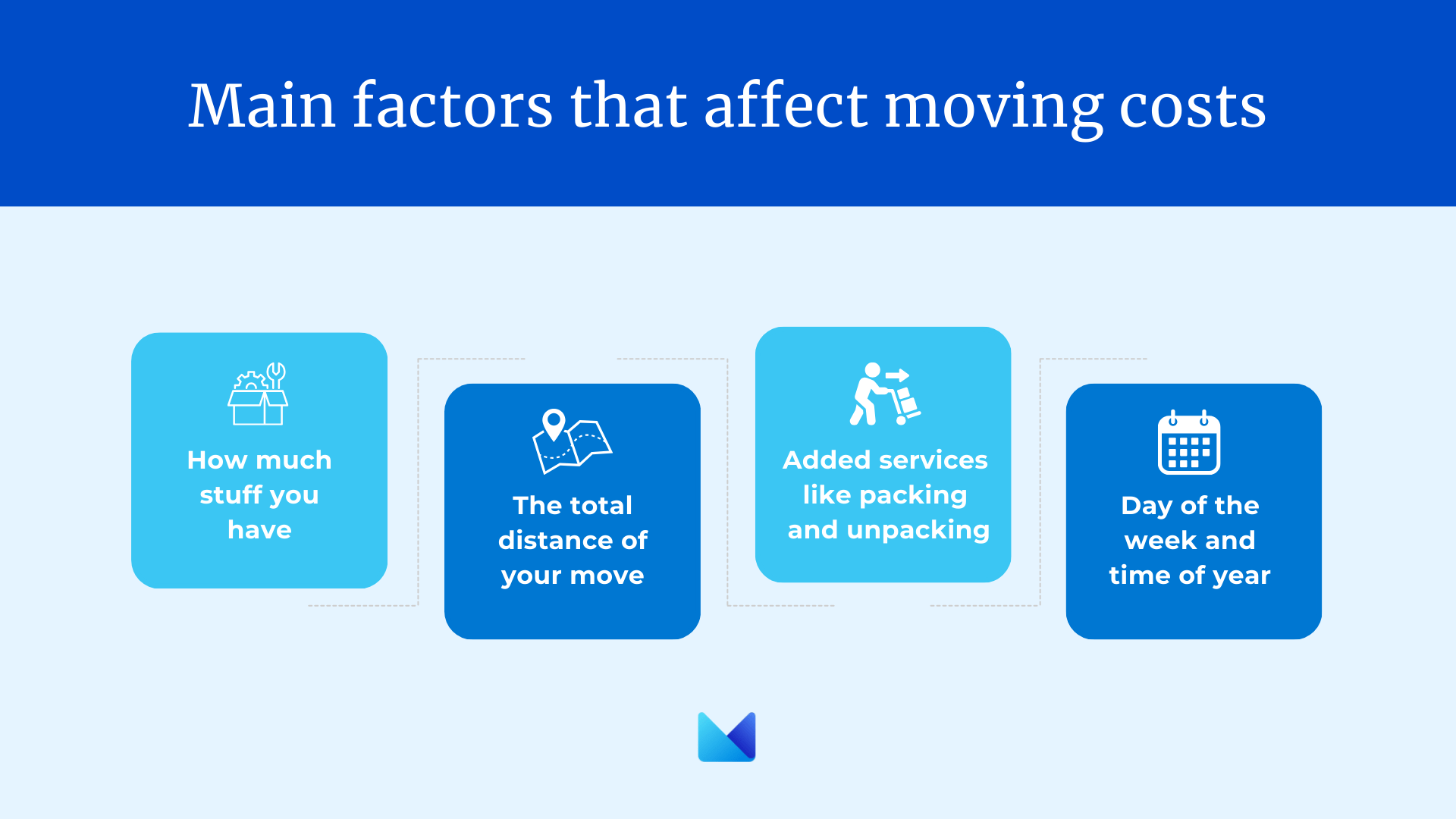PODS vs. U-Haul (Moving Containers vs. Truck Rentals)
Here’s the quick answer: When you’re choosing between a portable storage service like PODS vs. U-Haul, the decision comes down to whether you want to drive a truck yourself and if you need storage. A rental truck is cheaper, but you’re on the hook for driving and getting your belongings into and out of storage. If you don’t want to drive or you need long-term storage, PODS or one of its alternatives is a solid choice.
|
|
|
If you’re interested in how one of our favorite moving container companies stacks up with one of the cheapest truck rentals out there, read on for a more detailed comparison.
You can also consult our Moving Cost Calculator for an up-to-date cost comparison.
Our track record










Compare PODS vs. U-Haul
Quick overview: PODS vs. rental trucks
First, let’s make a broad comparison between moving containers like PODS and rental trucks.
| PODS | Rental Truck | |
|---|---|---|
| Driving | PODS does all the driving door-to-door | You drive the rental truck |
| Pricing | PODS includes gas and tolls in their base price | You pay gas, tolls, mileage, etc., in addition to the base price |
| Storage | 30 days of storage included in base price with options for long-term storage | No storage options except unloading into a storage unit on your own |
| Sizing | PODS has 3 sizes: 10′, 12′, & 16′ containers | U-Haul has pickup trucks and 10′, 15′, 20′, and 26′ trucks |
| Labor | Can hire loaders separately | Can hire loaders separately |
| Delivery | Delivery scheduling is required; PODS has weekend restrictions | You control when your items arrive |
| Car | PODS allow motorcycles to be shipped inside the container, but not larger vehicles | Rental trucks usually offer car towing options |
| Parking | PODS can be challenging to park | Rental trucks are street-legal almost everywhere |
PODS vs. moving truck rental: Cost
Estimating exactly what a move can cost with a rental truck vs. PODS is tricky because every move is different.
Here are a few factors that can affect the cost of your move:

With container moving companies, your quote will include drop-off and pickup fees, transportation fees, storage fees, and sometimes fuel surcharges or per-mile fees.
Meanwhile, truck rental companies often have base day rates, mileage fees, gas fees, environmental fees, and late-return fees. Here are a few sample quotes to give you an idea of what it costs to move with a container company vs. a rental truck:
Cost for a local move
| Container company | Rental Truck | |
|---|---|---|
| 1 bedroom | $150 – $600 | $20 – $200 (plus per-mile rate) |
| 2-3 bedrooms | $200 – $700 | $20 – $50 (plus per-mile rate) |
| 4-5 bedrooms | $300 – $800 | $40 – $100 (plus per-mile rate) |
Cost for a move < 250 miles
| Container company | Rental Truck | |
|---|---|---|
| 1 bedroom | $450 – $1,300 | $289 – $350 plus fuel costs |
| 2-3 bedrooms | $660 – $2,000 | $289 – $350 plus fuel costs |
| 4-5 bedrooms | $800 – $3,400 | $300 – $600 plus fuel costs |
Cost for a cross-country move
| Container company | Rental Truck | |
|---|---|---|
| 1 bedroom | $1,200 – $4,000 | $800 – $1,900 plus fuel costs |
| 2-3 bedrooms | $2,400 – $4,900 | $1,200 – $2,850 plus fuel costs |
| 4-5 bedrooms | $3,500 – $7,600 | $1,800 – $3,100 plus fuel costs |
As you can see, PODS costs are typically higher than truck rentals, but MoveBuddha customers can get a 10% discount. New customers are also eligible for several markdowns.
- For local moving: PODS gives new customers 10% off their initial delivery and 10% off the first month’s rental.
- For long-distance moving: PODS offers new customers 10% off initial delivery, 10% off the first month’s rental, and 10% off long-distance transit.
- For returning customers: The company runs a number of promotions throughout the year to help lower costs for PODS customers.
Container companies’ prices are pretty variable, so you should get online quotes from PODS’ competitors like U-Haul’s U-Box service. You can check out our comparison of U-Haul U-Box vs. PODS to see how it stacks up.
|
|
|
|
|
|
PODS vs. moving truck rental: How each service works
Understanding the basics of using PODS vs U-Haul can help you determine which option is best for your move.
Here’s how using a PODS container generally works:
- Book and schedule drop-off: You book your move and schedule a date and time to have your containers dropped off. You do all the packing and loading yourself and decide how much time you need to pack.
- Pack your container: Once your container is packed, the container company sends a professional driver to pick it up and transport it to your new address. You can also leave it at a storage facility.
- Unpack and schedule pick-up: After your container is dropped off at your new home, you do all the unloading and unpacking. You’ll also schedule a date and time for the company to pick up the empty container.
Here’s how a moving truck rental generally works:
Truck rentals are similar, but with one big, key difference in services: You have to do all the driving and towing yourself.
- Book and schedule pick-up: You book your move and schedule a date and time to pick up your rental truck, which you then drive yourself. You’ll typically also schedule your drop-off date during the booking process.
- Pack, load, and drive: You do all the packing and loading, then drive to your new home and do all the unloading and unpacking.
- Return: Next, you’ll drive the rental truck to an agency to return it.
PODS vs. moving truck rental: Pros and cons
Even the best moving container companies and rental truck companies have their advantages and disadvantages.
- PODS: With PODS, you know your belongings are in safe hands from Point A to Point B. This can be especially helpful for long-distance moves, but many areas don’t allow you to leave a large container on the street, and container costs can be higher.
- Rental trucks: Rental trucks are the best way to move on a tight budget, but they sometimes have hidden fees and require you to do all the work. They’re especially impractical if you need storage.
Container company pros & cons
- A professional does all the driving
- Many companies give you a minimum 30-day rental period, so you can take your time
- Temporary storage is often included, with no unloading required
- Most companies offer multiple sizes of containers
- Widely available in the U.S. and Canada
- Generally more expensive than getting a rental truck
- Prices really vary from company to company
- Large containers can be tough to park on or near your property, especially in urban areas
Rental truck pros & cons
- More affordable than a full-service move and most container companies
- Storage is sometimes included
- Most companies offer multiple sizes of trucks
- Widely available in the U.S. and Canada
- You have to do all the driving
- You’ll have to load and unload the truck multiple times if you need temporary storage
- You need to look out for hidden fees
- What’s included in your quote varies a ton from company to company
PODS vs. moving truck rental: Availability
One factor that can determine whether PODS or a U-Haul is better for you is the type of property you’re moving to or from.
- Urban areas: While it can be hard for a larger moving container or rental truck to navigate urban spaces with limited parking, both types of companies usually offer smaller vehicles to help with that problem.
- Rural areas: Getting a container to a rural location may be costly or impossible. As long as you can pick up and drive a moving truck, you’re set. Just note that mileage fees can add up if you’re far from the rental agency.
PODS vs moving truck rental: Sizes
Container companies and moving truck rental agencies generally offer a variety of sizes so you can choose what works best for you.
- Container companies: The average company offers 2-3 container sizes, and you can book more than one. PODS offers 8-, 12-, and 16-foot containers. The largest size is ideal for up to a 1,200-square-foot home.
- Truck rental agencies: Truck rental agencies have several truck sizes. U-Haul’s options range from pickup trucks to 26-foot moving trucks, which can move anything from a small studio apartment to a 3-4 bedroom home.
Some companies have more limited size selections than others, and offerings can also vary by location, so make sure to check with local companies near you to see what’s available.
We show you how to choose the right container for your move in our article on PODS sizes.
PODS vs U-Haul: Which is better?
If cost is the most important factor for you and you don’t need storage, go with a fully DIY move by renting a moving truck like U-Haul, since it’s almost always cheaper than a container company.
If you don’t want to drive or tow anything and need storage, a container company like PODS is better.
The right moving services for your move ultimately come down to pricing and what type of service will work best for your needs. Compare the costs and how much work you’re willing to put into your move to find the right solution for your needs.
Not what you were looking for?
Check out other categories that can help you find the information you need!








